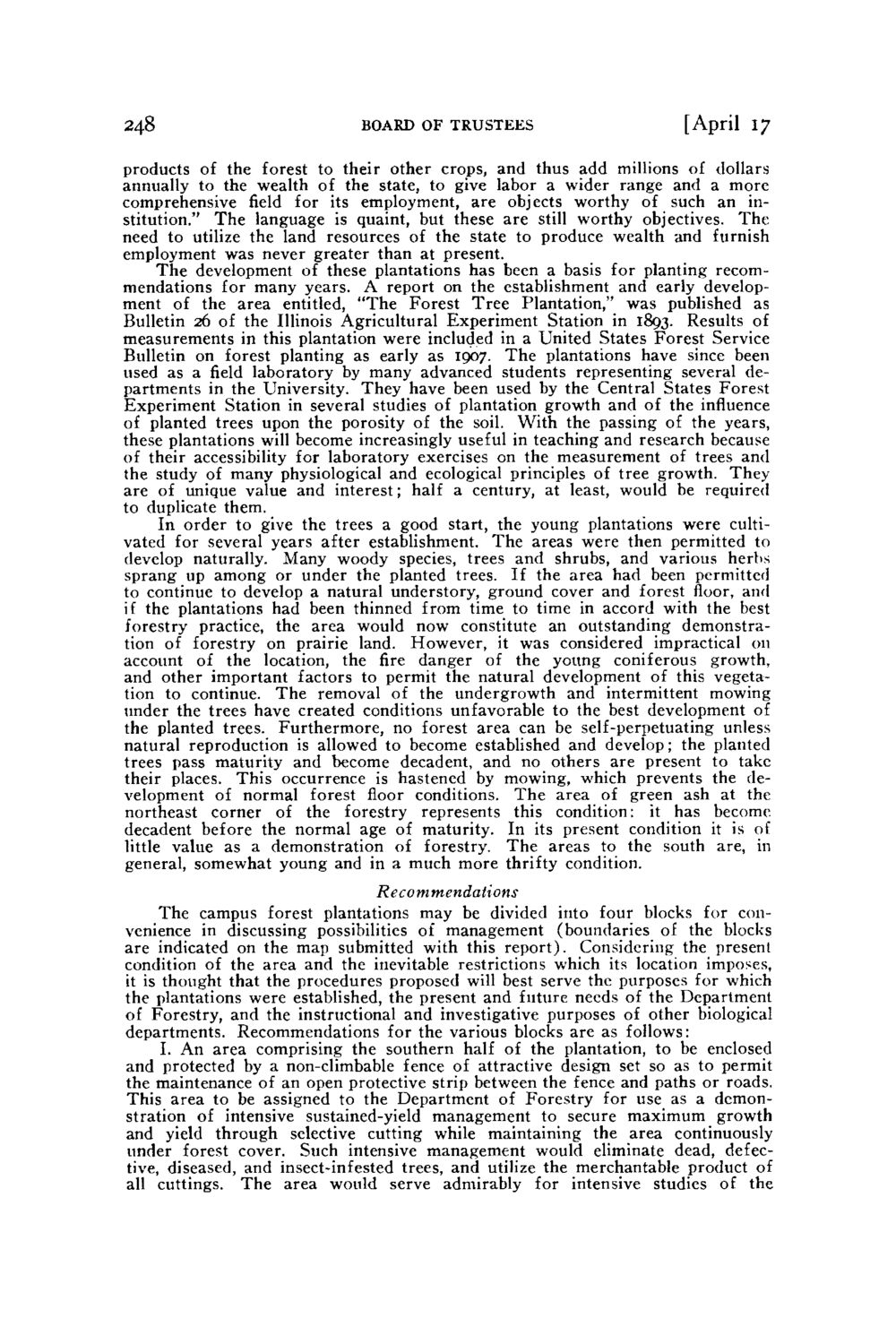| |
| |
Caption: Board of Trustees Minutes - 1942
This is a reduced-resolution page image for fast online browsing.

EXTRACTED TEXT FROM PAGE:
248 BOARD OF TRUSTEES [April ij products of the forest to their other crops, and thus add millions of dollars annually to the wealth of the state, to give labor a wider range and a more comprehensive field for its employment, are objects worthy of such an institution." T h e language is quaint, but these are still worthy objectives. T h e need to utilize the land resources of the state to produce wealth and furnish employment was never greater than at present. T h e development of these plantations has been a basis for planting recommendations for many years. A report on the establishment and early development of the area entitled, "The Forest T r e e Plantation," was published as Bulletin 26 of the Illinois Agricultural Experiment Station in 1893. Results of measurements in this plantation were included in a United States Forest Service Bulletin on forest planting as early as 1907. T h e plantations have since been used as a field laboratory by many advanced students representing several departments in the University. They have been used by the Central States Forest Experiment Station in several studies of plantation growth and of the influence of planted trees upon the porosity of the soil. With the passing of the years, these plantations will become increasingly useful in teaching and research because of their accessibility for laboratory exercises on the measurement of trees and the study of many physiological and ecological principles of tree growth. They are of unique value and interest; half a century, at least, would be required to duplicate them. In order to give the trees a good start, the young plantations were cultivated for several years after establishment. The areas were then permitted to develop naturally. Many woody species, trees and shrubs, and various herbs sprang up among or under the planted trees. If the area had been permitted to continue to develop a natural understory, ground cover and forest floor, and if the plantations had been thinned from time to time in accord with the best forestry practice, the area would now constitute an outstanding demonstration of forestry on prairie land. However, it was considered impractical on account of the location, the fire danger of the young coniferous growth, and other important factors to permit the natural development of this vegetation to continue. T h e removal of the undergrowth and intermittent mowing under the trees have created conditions unfavorable to the best development of the planted trees. Furthermore, no forest area can be self-perpetuating unless natural reproduction is allowed to become established and develop; the planted trees pass maturity and become decadent, and no others are present to take their places. This occurrence is hastened by mowing, which prevents the development of normal forest floor conditions. T h e area of green ash at the northeast corner of the forestry represents this condition: it has become decadent before the normal age of maturity. In its present condition it is of little value as a demonstration of forestry. T h e areas to the south are, in general, somewhat young and in a much more thrifty condition. Recommendations The campus forest plantations may be divided into four blocks for convenience in discussing possibilities of management (boundaries of the blocks are indicated on the map submitted with this report). Considering the present condition of the area and the inevitable restrictions which its location imposes, it is thought that the procedures proposed will best serve the purposes for which the plantations were established, the present and future needs of the Department of Forestry, and the instructional and investigative purposes of other biological departments. Recommendations for the various blocks are as follows: I. An area comprising the southern half of the plantation, to be enclosed and protected by a non-climbable fence of attractive design set so as to permit the maintenance of an open protective strip between the fence and paths or roads. This area to be assigned to the Department of Forestry for use as a demonstration of intensive sustained-yield management to secure maximum growth and yield through selective cutting while maintaining the area continuously under forest cover. Such intensive management would eliminate dead, defective, diseased, and insect-infested trees, and utilize the merchantable product of all cuttings. The area would serve admirably for intensive studies of the
| |